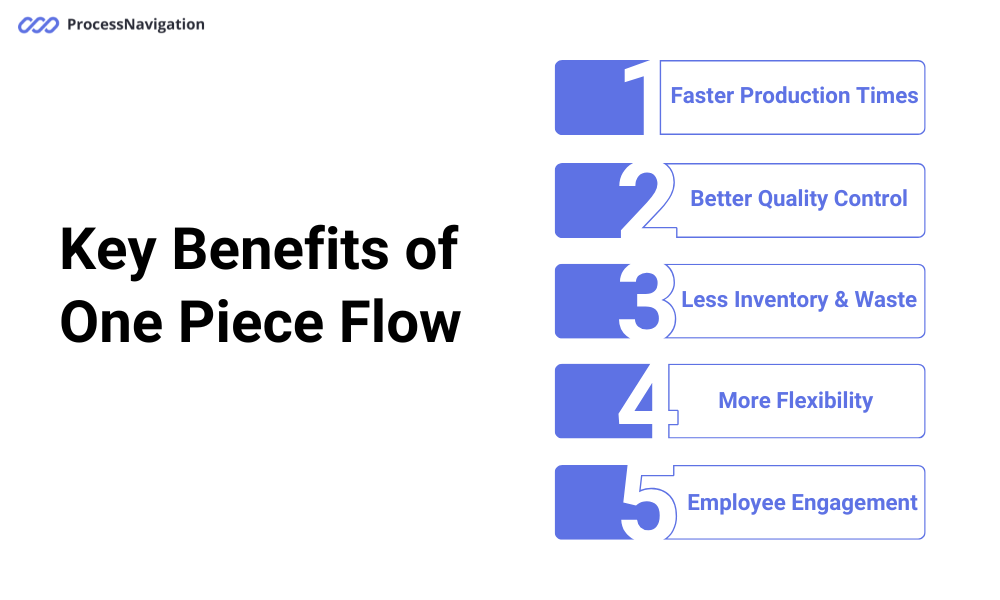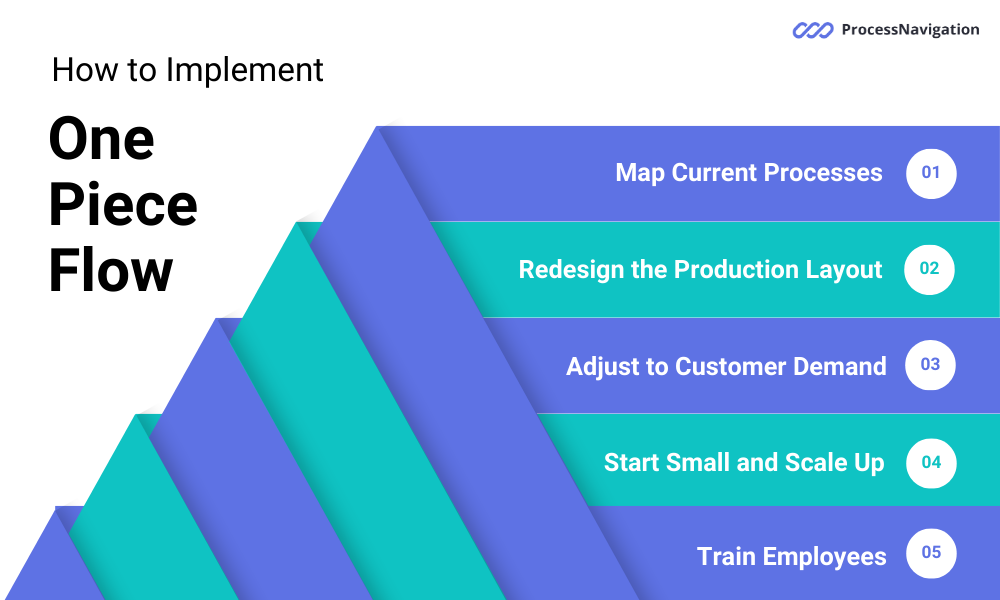In today’s manufacturing world businesses are under pressure to get more productive, reduce waste and simplify their operations. Customer demand for higher quality and faster production times has made batch processing seem old fashioned and inefficient. Enter One Piece Flow, a concept that has changed the way companies think about production efficiency. In this guide we will cover the principles of One Piece Flow, the benefits, practical steps to implement, the challenges and a real life case study of Toyota’s implementation of this method. By the end of this guide you will know how One Piece Flow can help your business get more efficient and operationally excellent.
What is One Piece Flow?
One Piece flow, also called continuous flow, is a method of production in which products or batches of products are manufactured and transferred to the next process step one at a time. In other words, the maximum stock between operations/stations/processes is one.
In traditional batch processing, multiple units of the same product are processed simultaneously at each stage of production, forcing products to wait for each other to complete. One Piece Flow, however, focuses on single-piece flow, completing one unit before proceeding to the next. This approach allows for a smoother flow of materials and a quicker transition from one stage of production to the next.
The Lean Manufacturing Connection
One Piece Flow is a lean manufacturing example, lean manufacturing is a management philosophy that reduces waste and maximizes customer value through the manufacturing process. Lean principles are based on the idea that organizations should continually improve by eliminating waste and focusing on what adds value. The goal is to add more value with less resources, so every part of the process adds to the final product in some way.
Lean manufacturing has 7 types of waste (or “muda” in Japanese):
- Overproduction: Making more than is needed, resulting in excess stock and higher storage costs.
- Waiting: Delay in the process, often caused by bottlenecks or waiting for materials or information.
- Transportation: Moving materials unnecessarily, wasting time and resources.
- Over Processing: Doing unnecessary work or using more resources than needed for a task.
- Inventory: Holding stock, tying up capital and increasing storage costs.
- Motion: Wasteful movement by people or machines that doesn’t add to the product.
- Defects: Making defective products that need rework or scrapping, adding extra cost.
One Piece Flow eliminates many of these wastes. By focusing on one item at a time, overproduction is reduced, waiting times are minimised and defects are caught early in the process. This streamlined approach means one piece flow cell production is more efficient, faster and better quality.

Key Benefits of One Piece Flow
The goal of One Piece Flow is to increase efficiency, product quality and customer satisfaction. Let’s get into some of the benefits:
1. Faster Production Times
One of the most obvious benefits of One Piece Flow is shorter production times. When products move one by one through the process there are no delays between stages. In batch processing products have to wait for others in the batch to be completed before they can move on. One Piece Flow eliminates those delays by working on each unit continuously and in real time.
This means shorter lead times and faster turnaround for customers. In industries where demand can change fast like consumer electronics or custom manufacturing, reducing production times allows businesses to respond quickly to customer demand needs and stay competitive.
2. Better Quality Control
In batch processing defects can go unnoticed until the whole batch is completed and then you have to rework or scrap the whole lot. One Piece Flow solves this problem by making it easier to detect defects early in the process. Since products move one by one through each stage, defects can be detected and fixed before they affect the next unit.
Workers are encouraged to stop the process if they see a defect, so defective products don’t move down the line. This proactive approach means quality is maintained throughout the process and reduces defects and rework. With fewer defective products manufacturers can increase customer satisfaction and reduce returns and repair costs.
3. Less Inventory and Waste
Batch processing often means large inventories of raw materials, work in progress and finished goods. These inventories take up valuable warehouse space and tie up capital that could be used elsewhere. One piece flow operation One Piece Flow minimizes inventory by producing only what’s needed when it’s needed.
One Piece Flow manufacturers avoid work in progress inventory by focusing on completing one product before moving on to the next. This eliminates the need to store large amounts of unfinished products and reduces storage costs and cash flow. By reducing waste and optimizing inventory businesses can increase their bottom line.
4. More Flexibility
Flexibility is another benefit of One Piece Flow. With batch processing switching between products often requires significant changes to the production line which can cause delays and longer setup times. One Piece Flow is more flexible because it processes one item at a time so it’s easier to switch between product variations or configurations without major disruptions.
In industries with fluctuating demand or frequent product changes the ability to respond to new requirements quickly is key. One Piece Flow allows businesses to respond to customer orders faster, reduce lead times and offer customized products.
5. More Employee Engagement
One Piece Flow can also increase employee engagement by giving workers more ownership of the process. In a batch system workers may only be responsible for a small part of the process and may not see the final product until the end. With One Piece Flow workers are responsible for the whole process from start to finish so they can take more pride in their work.
By giving employees ownership of quality and continuous improvement One Piece Flow creates a sense of responsibility and accountability. Workers will take more ownership of problems, solutions and the process itself which means a more engaged and productive workforce.

How to Implement One Piece Flow: A Step-by-Step Guide
One Piece Flow requires planning, continuous improvement and the right tools and resources for the process. Here are the steps to implement One Piece Flow:
1. Map Current Processes
Before you can implement One Piece Flow you need to map your current processes to see where to improve. This means mapping the flow of materials, identifying weaknesses and where delays and inefficiencies occur. Value Stream Mapping (VSM) is a great tool to visualise the whole process and see where the waste or inefficiency is.
Once you know your current processes you can develop a plan to streamline and eliminate waste. Focus on the weaknesses, excessive waiting times or quality issues and see how One Piece Flow can fix them.
2. Redesign the Production Layout
For One Piece Flow to work the layout of the standardized work on the production floor needs to be optimized. Workstations need to be arranged so that products can flow from one step to the next with minimal transportation or material handling.
Think about the flow of materials and products across the production floor. Minimize unnecessary movement, reduce waiting times and make sure each workstation has the tools and equipment to do the job. A well designed layout will help the transition between production stages and increase the overall process efficiency.
3. Train Employees
Training is a key part of One Piece Flow implementation. Employees need to understand lean principles, the importance of waste reduction and their role in One Piece Flow production.
Training should focus on helping workers understand the flow of materials, how to spot and fix defects and how to work with colleagues to improve the overall process. Encourage a culture of continuous improvement as this will empower employees to own the process and suggest improvements.
4. Start Small and Scale Up
Implementing One Piece Flow across the whole process can be overwhelming especially for companies new to lean principles. Instead start small by selecting one production line or product to implement One Piece Flow. This will allow you to test the system, measure the impact and adjust before rolling it out to other areas.
Use the initial implementation as a learning experience to refine the process and make sure it’s working as intended. Once the system is running in one area of the pull system you can roll it out to other areas of the production process.
5. Measure and Adjust to Customer Demand
Once One Piece Flow is up and running you need to continuously measure. Key metrics such as cycle time, throughput, defect rates and lead times should be measured regularly. Use this data to identify bottlenecks, inefficiencies or quality issues that need to be fixed.
Measure and you can adjust the process, train the workers and refine the system for better results. Continuous improvement is at the heart of lean and measurement is key to long term success.
Case Study: Toyota’s Adoption of One Piece Flow
Toyota is credited with One Piece Flow, because of Taiichi Ohno’s development of the Toyota Production System (TPS) in the 1950s. TPS was created to get rid of waste and improve efficiency and One Piece Flow was one of the principles.
In the early days of Toyota’s production system, they had big problems with batch production. Big inventories of unfinished cars were piling up on the production line, causing inefficiencies and delays. They decided to use One Piece Flow to fix this.
By using One Piece Flow Toyota was able to reduce inventory, increase production speed and cut waste. Workers got involved in the process of production, so each car was built to the highest quality. They also introduced Jidoka, a system where workers could stop the production line if a problem occurred, so issues could be fixed in real time, not at the end of the batch.
The results were amazing. Toyota was able to reduce lead times, improve product quality and customer satisfaction. Today Toyota’s production system is the benchmark and is used by manufacturers all over the world.
Conclusion
Master One Piece Flow and you’ll get more efficiency, less waste and better product. By applying this lean principle companies can simplify their processes, reduce lead times and create a culture of continuous improvement. Whether you are a small manufacturer or a big multinational, One Piece Flow can be a game changer for your business.
With proper implementation, employee training and ongoing monitoring, companies can master One Piece Flow and get faster, more efficient and better production. Follow the steps in this guide and learn from successful case studies like Toyota and you’ll take your manufacturing to the next level and stay ahead of the competition.
-
 Maintenance Plan: What Is It And How Does It Work
Maintenance Plan: What Is It And How Does It WorkIn modern manufacturing, equipment downtime costs businesses thousands of dollars an hour. The difference between...
Technology
-
 Competency Management
Competency ManagementModern businesses face a big challenge: how do you ensure every employee has the skills...
Technology
-
 Unlocking the Benefits of Total Quality Management
Unlocking the Benefits of Total Quality ManagementIn today’s competitive world, the quality of products and services is becoming the key to...
Technology
